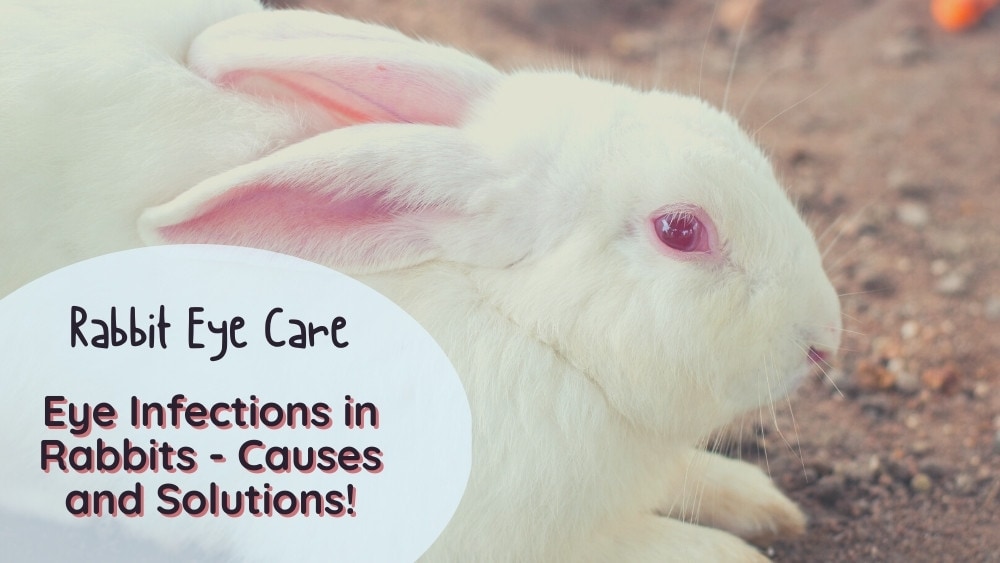Rabbits are known for their large, alert eyes, set perfectly on each side to give them almost 360-degree vision of their surroundings – and any predators trying to creep up on them! But these eyes are also a rabbit’s Achilles heel, because it makes them vulnerable to injury and infections.
Rabbit eye problems are common, accounting for around a third of cases that I’ve seen in veterinary practice. While many eye infections can be treated quite easily, others can progress to become chronic problems, either because they are brought to the clinic too late, or because there is a complicated underlying cause that needs to be addressed.
In this article, I’ll give you the run-down on rabbit eye infections, covering:
- What is an eye infection in rabbits?
- How to spot a rabbit eye infection
- What you should do if you think your rabbit’s eye is infected
- What precautionary measures you should have in place.
What is Pink Eye or Eye Infection in Rabbits?
Rabbit pink eye, or eye infection, is characterized by eyes that are red and sore with a sticky discharge. As well as being caused by viruses and bacteria, rabbit eyes can get infected due to tear duct or dental issues, allergies or injuries.
Eye infections in rabbits can quickly become serious, and sometimes lead to the loss of the eye. It is recommended to check your rabbits’ eyes regularly, and seek veterinary care as soon as you notice any symptoms.
Causes of Infection in a Rabbit’s Eye
Rabbits are particularly susceptible to eye infections and conjunctivitis, which have a number of causes. Here are the most common reasons for rabbit eye infections that we see in veterinary clinics.
Blocked tear ducts
Blocked tear ducts are associated with abnormal tear flow in your rabbit’s eyes. Tear duct problems are common in rabbits and can be due to the following:
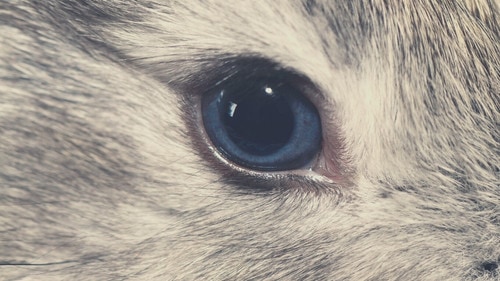
Inflammation in tear ducts
Tear duct inflammation can be referred to as rabbit weepy eye or dacryocystitis, and can affect one or both of the eyes. The tear ducts of the rabbits are long, narrow, and winding, so if the ducts swell with inflammation, tears can’t pass through properly.
Allergies
Allergies to dust, insects, and pollen can also lead to blocked nasolacrimal ducts. Dust from hay and bedding can affect the rabbits’ healthy eyes. The key here is to find potential irritants in a rabbit’s environment. While dust is the most common allergy trigger, other irritants can still affect rabbits in a dust-free environment.

Dental disease
Infections of the tooth roots are a common cause of tear duct problems.
Overgrown upper tooth roots can press on the nasolacrimal ducts, causing the tear ducts to kink and block. You may notice a visible bump on your rabbit’s cheek. In other cases, the dental infection can even lead to an abscess behind the eye that pushes it forward.
Damage to the rabbit’s eye
Physical damage to the rabbit’s eye is another cause of eye infections, as it damages the protective corneal layer over the eye and leaves it susceptible to infection by bacteria from the environment. There are several types of damage that can occur:
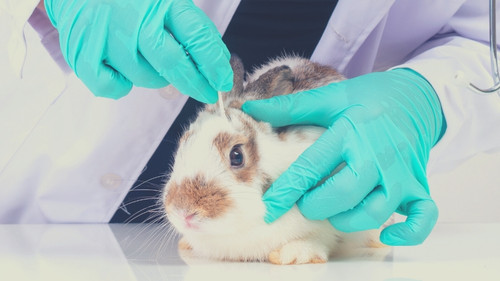
Trauma
Trauma happens when something bashes the eye, causing an injury. This can happen when rabbits fight, or if your furry pal runs into something when they’re scared. Trauma to the eye is pretty common, as the eye placement in a rabbit does create some blind spots.
Trauma can lead to ulcers as a result of the damaged cornea. In the worst cases, trauma can even cause a puncture or a wound in the rabbit’s eyeball itself.
Foreign object in the rabbit’s eyes
The large eyes of a rabbit are important in the wild because they help it to spot predators. However, these eyes can also make bunnies susceptible to getting a foreign body in the eye, which scratches at the cornea.
Food and large enough dust particles are common foreign objects that can damage a rabbit’s eye, but straw and hay particles also cause damage.
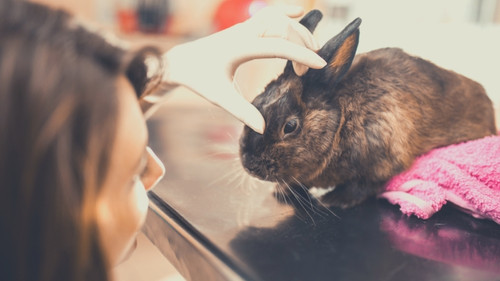
Abnormal eyelid
Some rabbits are born with abnormal eyelids, and as a result their eyelids or eyelashes constantly irritate the surface of the eye. This condition is called entropion, which refers to eyelids rolled inwards.
Entropion can start as a mild problem, but quickly advance into a severe issue.
While rare, rabbits may have an abnormally shaped lower eyelid, so the tear duct is not in the right place.
Infectious agents
While bacteria are usually involved in rabbit eye infections, they often only move in after the eye has been damaged in some way. This is called a secondary infection.
In some cases, however, the infectious agent is the main cause of the rabbit’s eye infection and is known as a primary infection.
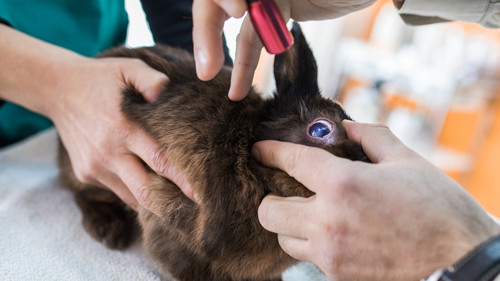
Bacterial infections
Rabbits are vulnerable to bacterial infections, which can occur when a rabbit lives in poor conditions or is exposed to dirty water. Bacterial infections can lead to sticky rabbit eye discharge, especially in elderly or very young rabbits, and pink eye is a symptom that is hard to miss.
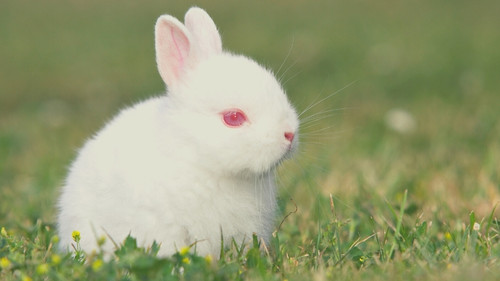
One specific bacterial infection affecting rabbit eyes, is Pasteurellosis, a respiratory tract infection that can also affect the eyes.
The bacteria can reside in the eye membrane, nasal cavity, or lungs without causing discomfort. However, when the rabbit is under stress, the bacteria multiply, leading to infection.
Viruses
Viruses can also cause serious eye infections. They are characterized by puffy eyelids and milky white discharge from the eyes.
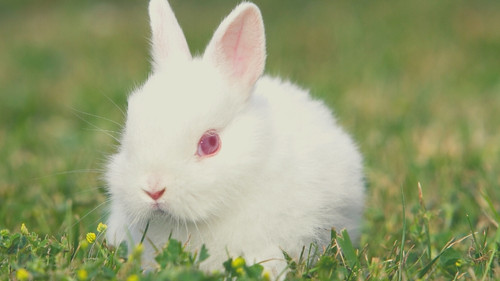
Wild rabbits carry the Myxoma virus, which causes myxomatosis. One key symptom of this disease is eye infections. Although the virus is not common in pet rabbits, your bunny can still get infected without direct contact, through mosquito bites. Fortunately, annual vaccination against myxomatosis can help protect them.
Parasites
Parasites can also be the underlying cause of eye disease, including encephalitozoon cuniculi. This is a microscopic parasitic organism that occupies the cells for survival.
It can reside in some rabbits without any signs, but when activated they cause inflammatory disease which affect the eyes, brain, and kidneys.
What Are the Symptoms of a Rabbit Eye Infection?
A rabbit’s symptoms are a crucial indicator of eye disease. These symptoms will include:
- Rabbit Weepy Eye – A rabbit’s eye area will become swollen, and the rabbit will have watery and runny eyes. Weeping or crusting around the eye is typical for diseases.
- Matted fur – Liquid from the eye makes fur around the eyes matted.
- Eye rubbing – You will often see your rabbits rubbing their eyes with their front paws. This is a constant behavior when they are suffering from the discomfort of eye diseases.
- Corneal damage – If you observe a white cloud-like layer on top of one or both eyes, it is time to take the bunny to the vet.
- Pain – You can tell that the disease is causing the rabbit pain by observing its squinting and blinking frequency. Inflammation is very irritating, and you will see the rabbit flinching when it blinks, or keeping its eyes closed.
- Iris prolapse – A protruding iris is a rare condition, but if you see a visible bump on the iris, it is a condition that needs to be treated immediately.
- Red, inflamed eyes – A change in the eye color of the bunnies indicates that they have an eye problem. Red eye is a significant indication of infection.
- Other symptoms – Other symptoms to consider include lethargy, eating, fever, depression, weight loss, and breathing difficulties.
How to Treat Eye Infections in Pet Rabbits?
Treatment for eye conditions will vary depending on the cause, and the most important thing is to get your rabbit checked by a vet as soon as possible.
While there may be YouTube tutorials on treating eye infections at home, there are often underlying causes that you can’t treat yourself, and could threaten your rabbit’s sight permanently.
Your vet will advise whether your rabbit needs a procedure to help the eye, tear duct, or teeth. For example, the vet can treat blocked ducts using a saline solution to flush out the ducts and eliminate any pus and infection. This is a procedure that is often done under anesthetic, and may need to be repeated at intervals to help keep the tear duct open.
Your vet will also prescribe antibiotics and anti-inflammatory medication as necessary to help your rabbit clear the infection and control the pain.
Follow your vet’s instructions, and make further consultations with the vet if the eye remains swollen. The key to effective treatment is fast response, limiting damage, and allowing the bunnies to recover quickly.
Home Remedies for Rabbit Eye Infections
The most important aspect of home remedies is following the vet’s instructions strictly. It is also important to use the eye drops prescribed for your rabbit.
Eye drops prescribed for other animals may have unpredictable effects when used on bunnies, and old tubes of eye cream you find in the medicine box tend to harbor bacteria, which can make the infection worse.
You can regularly bathe the rabbit’s eyes using cotton wool and cooled boiled water to remove any discharge. Another recommended home treatment is artificial tears to ensure that the rabbits’ eyes remain moist during the healing process.
When your rabbit’s eye infection is an emergency
All rabbit eye infections should be examined by a vet, but there are some cases where you should go to the clinic as an emergency.
Get your rabbit to a vet within an hour if:
- you see any visible bumps around the cheek or eye
- the eye itself appears to be popping out of its socket
- the iris (the colored part inside the eye) is protruding or looking out of shape
- the swollen pink flesh of the eye is making it nearly impossible for your rabbit to open its eye
- your rabbit can’t settle, or keeps pawing at the eye
- you see other symptoms that worry you, including foaming of the mouth or bloody nasal discharge
How to Prevent Rabbit Eye Infections?
Preventive measures are the best approach to tackle eye conditions before they develop. Here are things you can do:
- A clean living environment is an easy measure but is key to preventing bacterial infections. Clean surfaces are crucial because bunnies use their paws to clean their eyes and ears.
- Regular bunny grooming will also be crucial in ensuring the bunnies stay healthy.
- Prevent dental disease by giving your bunny the right diet, which consists of high fiber.
- Bunny owners should also limit access to foreign bodies, such as sticks or anything that could easily damage the bunnies’ eyes. Air purifiers can help reduce dust.
- Perform regular checks on the rabbit’s eyes and behavior to recognize any problems early.
- Vaccinations against viral infections such as myxomatosis.
Conclusion
Eye infections in rabbits are a common but usually treatable condition. The key to a good result is getting your rabbit to the vet as early as possible, and following treatment instructions closely. As rabbits often don’t let us know in the early stages of their health issues, keeping a close eye on your rabbit’s behavior and body language is crucial.
If you found this rabbit eye infection guide helpful, please share it with your friends and family that have pet rabbits. Still got questions? Ask us in the comments below!


